
The RABDe 500, is a Swiss high speed passenger train which was introduced in 2000, in time for Expo.02 held in western Switzerland in 2002. Its maximum speed is 200 km/h (120 mph), which can be reached on the Mattstetten–Rothrist new line; as of 2018 the RABDe 500 uses the branch to Solothurn only; the ICNs reach 200 km/h in the new Gotthard Base Tunnel. The train sets were a joint development by Bombardier, Swiss Federal Railways and Alstom, with an aerodynamic body designed by Pininfarina, bogies and tilting mechanism designed by the then SIG, Schweizerische Industrie Gesellschaft.
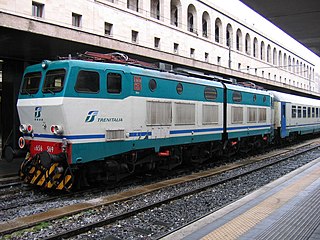
A Bo-Bo-Bo or Bo′Bo′Bo′ is a locomotive with three independent two-axle bogies with all axles powered by separate traction motors. In the AAR system, this is simplified to B-B-B.
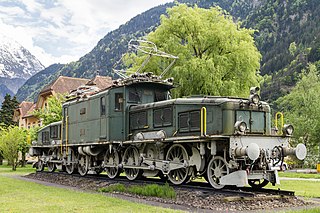
Crocodile electric locomotives are so called because they have long "noses" at each end, reminiscent of the snout of a crocodile. These contain the motors and drive axles, and are connected by an articulated center section. The center section usually contains the crew compartments, pantographs and transformer.

Alstom Traxx is a modular product platform of mainline diesel-electric and electric locomotives produced originally by Bombardier Transportation and later Alstom, which was built in both freight and passenger variants. The first version was a dual-voltage AC locomotive built for German railways from the year 2000. Later types included DC versions, as well as quadruple-voltage machines, able to operate on most European electrification schemes: 1.5/3.0 kV DC and 15/25 kV AC. The family was expanded in 2006 to include diesel-powered versions. Elements common to all variants include steel bodyshells, two bogies with two powered axles each, three-phase asynchronous induction motors, cooling exhausts on the roof edges, and wheel disc brakes.
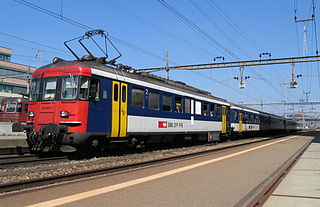
Starting in 1959, the SBB motor coach of the type RBe 4/4 was for a replacement of the old SBB electric locomotives Ae 3/6 I, Ae 3/6 II, Ae 3/6 III and SBB Ae 3/5 with three driving axles. As a consequence, they had much power at their disposal, even more than the Re 4/4 I locomotives, a regenerative brake, cabs on both ends with doors to passenger carriages as well as Multiple-unit train control SBB Vst IIId for multiple-unit or driving trailer. They originally motor coach had 64 seats, 32 smoking and 32 non-smoking, and were painted in ordinary SBB green.

The class E 10 is an electric locomotive of the Deutsche Bundesbahn, introduced in 1952. It belongs to the Einheits-Elektrolokomotiven program and was built for express passenger service. In 1968 the series was redesignated as class 110 (E10) and class 112 (E10.12). In 1988 the last series of class 112 locomotives were designated as class 114, and in 1991 the remaining locomotives of class 112 were designated as class 113. In 2006 38 locomotives were designated as class 115.

The Ae 6/6 is a heavy electric locomotive used by the Swiss Federal Railways (SBB-CFF-FFS). It is sometimes also referred to as canton locomotive ("Kantonslokomotive"), because the first 25 locomotives were named after the cantons, and carried the canton's coat of arms on the side and chrome embellishments, and the Swiss coat of arms on the front, between the chrome stripes. These adornments made them internationally famous. The other 95 locomotives received the names of capital cities of Swiss cantons, and other towns and cities, but without the chrome embellishments. The namings were held as ceremonies in the respective cities. A less appealing moniker is Schienenwolf as the three axle bogie construction stresses heavily the tracks.

The Re 420, originally Re 4/4II, series are the most common electric locomotives of the Swiss Federal Railways. They are used for passenger services throughout Switzerland alone or in pairs. For freight services, they are sometimes paired with the Re 620, especially in mountainous regions. That pairing is referred to by the term Re 10/10. The Re 430, originally known as the Re 4/4III, are a derivative of the Re 420 modified for higher traction but lower speed.
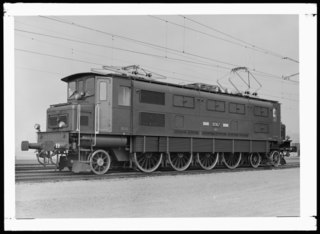
The Ae 4/7 was a universal locomotive of the Swiss Federal Railways, employing the so-called Buchli drive.
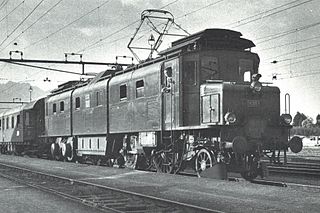
The Ae 4/8 was a prototype locomotive of the Schweizerischen Bundesbahnen (SBB) for the testing of electrical operation. The locomotive was equipped with two different drives, therefore acquiring the nickname Bastard. Because of its three-part locomotive body it also acquired the nickname Tatzelwurm.

The Be 3/5 11201 was one of four test locomotives ordered by the Schweizerischen Bundesbahnen (SBB) in June 1917. Intended to provide experience with electric traction, the locomotive was intended, along with Be 4/6 12301, Be 4/6 12302 and Ce 6/8I14201, to be used on services on the Gotthardbahn. The Be 3/5 was something of a stopgap offered by Maschinenfabrik Oerlikon (MFO) because they felt that the requirements required for the Gotthard Railway could not be fulfilled at the time. As the MFO did not feel that it could produce a freight locomotive with six drive-axles, a smaller version of the BLS Be 5/7 was offered. This meant that the locomotive did not fulfil the SBB specifications for the Gotthard line; it was too weak and, compared with the A 3/5 steam locomotives, too slow. However, due to a lack of available stock, the railway still took delivery of the locomotive, a decision later proved correct by the long operational life and reliability of the Be 3/5.
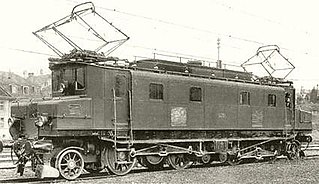
The Be 4/6 12301 was one of four test locomotives ordered by the Schweizerische Bundesbahnen (SBB) in June 1917. For gaining experience for ordering electrical locomotives this locomotive should – as her three sisters Be 3/5 12201, Be 4/6 12302 and Ce 6/8I14201 – have been used for services on the Gotthardbahn. The Be 4/6 12301 was the alternative design of MFO for a fast train locomotive for the Gotthard railway line. She was designed and built according to the requirement specifications of the SBB. But – except for occasional trips to the maintenance shop of Bellinzona – did not appear on the Gotthard railway line. The design was intrinsically reliable. The locomotive operated for 44 years in very various services. The locomotive drivers liked the locomotive because her driving behaviour was very smooth even at top speed. But technically the locomotive was much more complicated than their sisters Be 4/6 12302 and Be 4/6 12303-12342.

The Be 4/6 12302 was one of four test locomotives ordered by the Schweizerische Bundesbahnen (SBB) in June 1917, along with the Be 3/5 12201, Be 4/6 12301 and Ce 6/8I14201. It was intended to be used on the Gotthardbahn, in order to gain experience in ordering and operating electric locomotives, However, the Be 4/6 12302 was never used for scheduled services on the Gotthard, because at its introduction it was already outperformed by the successor class Be 4/6 12303-12342.
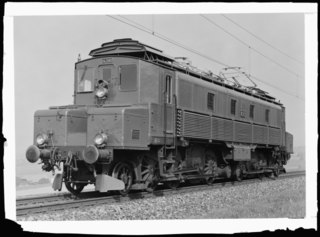
The Ce 6/8 I 14201' was one of four test locomotives ordered by the Schweizerischen Bundesbahnen (SBB) in June 1917. For gaining experience for ordering electrical locomotives this locomotive should – as its three siblings Be 3/5 12201, Be 4/6 12301 and Be 4/6 12302 – have been used for services on the Gotthardbahn. The development of freight locomotives subsequently took a completely different way which was not conceivable at the ordering date. The Ce 6/8I came into service only after the first Ce 6/8II.

The SBB-CFF-FFS Ae 8/14 is a class of electric locomotives built for Swiss Federal Railways to be used on the Gotthard railway. Only three prototype engines were built between 1931 and 1938, each of them in a different design.
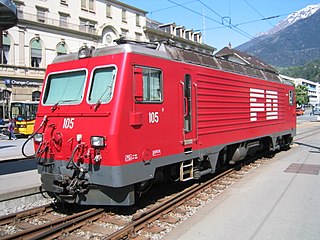
The HGe 4/4 II is a combined adhesion and cogwheel-equipped electric locomotive used on a number of metre gauge railways in Switzerland since 1985.

The Be 4/6 was a bogie locomotive operated by the Schweizerischen Bundesbahnen (SBB) on the Gotthard Railway along with the Be 3/5, The design was based on the prototype Be 4/6 12302.

The Swiss locomotive class Ae 4/6 was a class of electric locomotives. They were intended as a powerful locomotive for the steep gradients of the Gotthard Railway, but smaller than the huge 'double locomotives' which had previously been tested there. They were built from 1941, during World War II, and although Switzerland remained neutral through this, material shortages led to some quality problems with these locomotives.
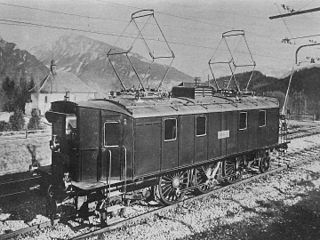
Midi E 3301 was a prototype electric locomotive of Class E 3300 designed for the Chemins de fer du Midi, France. Because of poor performance, it was refused by the Compagnie du Midi and was re-deployed to Swiss railways. On 1 May 1919, it was classified Fb 2/5 11001 and, in 1920, it became experimental locomotive Be 2/5 11001 of the Swiss Federal Railways (SBB).

Rigid-framed electric locomotives were some of the first generations of electric locomotive design. When these began the traction motors of these early locomotives, particularly with AC motors, were too large and heavy to be mounted directly to the axles and so were carried on the frame. One of the initial simplest wheel arrangements for a mainline electric locomotive, from around 1900, was the 1′C1′ arrangement, in UIC classification.



























